Hilo, HI 7-nov-2019 — I think I may have redeveloped a caffeine addiction. By 2009, I was up to twelve espresso a day, and then quit, cold turkey. It took two years before I no longer got that heavy dentist’s x-Ray blanket feeling from no caffeine.
To combat sleep on overnight watches, Jennifer and I bought a couple of pounds of chocolate-covered espresso beans. At first, as all addictions proceed, two delicious beans would keep me for an hour. Surprisingly, given these beans were bought at discount supermarket Winco, the chocolate was excellent with real cocoa butter. Overtime, as we made our way south to San Diego, then across to Hilo, I became unafraid of the magic beans. Several became a delightful satisfying calorie as well as caffeine boost. Now look at the wretch I have become: heavy lidded in the afternoon, catching naps.
The only surprise we found on Caro Babbo, we found yesterday. The port locker in the aft cabin was full of rusty water. This continues the mystery of the aft cabin starboard locker, which also mysteriously filled with water. My final solution was to treat the symptom, not the cause, and drill a hole in the bottom of the locker to let the water drain.

My fellow Maxi 95 owners tell me it is the rudder post, but I haven’t made the mechanics work to have water flow from a locker wth a drain over a partition into to a locker without one.
When the starboard locker was filling, it would do so at anchor, ruling out the rudder post, because its locker was empty and dry.
I was asked recently why I bought a Maxi 95. There are many reasons, among which are a full bow section and an aft cabin. While the aft cabin was originally planned as a way to have two teenage children have privacy and travel with us, it has become an amazing storage locker swallowing sail bags and fenders, life jackets and voluminous guest bedding, out of sight and out of the way.
A full bow section is more controversial and a more unusual feature to praise. While boat manufacturers, until recently, weren’t very good marketers, sailing magazines have dictated what matters in a sail boat for generations. In my life maximum bunks as the key selling feature has been replaced by IOR ratings and PHRF ratings and the rating-related features, like short booms and tall masts, now it is full sterns and hard chines. “Fine entry” had been something to brag about for as long as I can remember: a fine narrow bow to cut through the waves. The narrow entry and cut through means lessened buoyancy, a wet deck and a buried bow. Exactly the opposite of what I am looking for. I want a bow that goes over the waves, not through them, a deck and especially a bow that stay dry, since that is where I will be standing when changing sails.
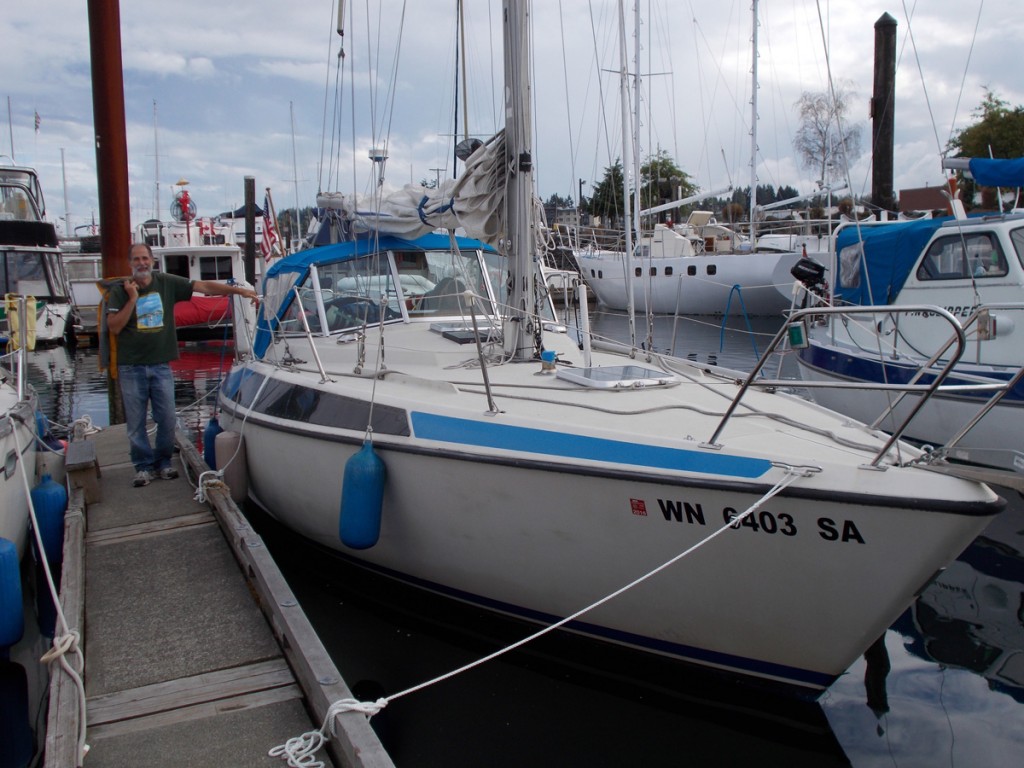
Caro Babbo also has tumble home, which seems to mean that the boat doesn’t heel like my previous boats.
So what is it like making a passage on Caro Babbo, a Maxi 95?
Before leaving on this venture, Jennifer and I had lived 15 of the previous 32 months aboard Caro Babbo on inside passage trips, plus another six or more living aboard on shorter trips and at Lee’s landing. We routinely cook, eat, wash and spend time aboard, but on a passage, how is it different?
Is it better than other boats, what about heavier ocean-going boats?
We can’t compare because this is the only boat we’ve made a passage on.
The start out of Neah Bay is something we’ve done before, but we’ve headed north along Vancouver Island to Uculet. This time we headed west for a few days to get offshore and around weather.
We were quickly sea sick. We expected to be. We slept in foulies in the cockpit the first two, possibly three nights. Jennifer vomited into the cover for the VHF radio and I vomited into the compass cover.
In the oven was a very deep dish blackberry pie that Jennifer made from the blackberries that grow outside Lee’s Landing. On our third day we started eating that pie and I made a thick pea soup that we ate during the coldest part of the night and for a mid-morning breakfast.
We spent much of the first bunch of days heeled between 18- and 22- degrees. We forgot to make lee cloths, so only one bunk was usable as intended.
Once we were far enough away from ships that we both could leave the cockpit, Jennifer would sleep on the lee side and I would sleep crosswise with my legs on the cabin table, my back on the bunk and my neck severely bent with my chin in my chest. I would come to pay for this.
Going to windward, as we did close to 40% of the trip, is referred to as bashing and all sailors pity every other sailor, especially those in light displacement boats. But we didn’t bash, we floated over the waves. The autohelm would have trouble when the sails weren’t properly balanced, by were never slammed into waves and slowed forward motion. Instead, when we weren’t cautiously reefed (as opposed to necessarily reefed), we routinely sailed faster than our hull speed.
In confused seas, we were banged with what sounded like wooden hammers that, on the Hilo leg of the voyage, would move the hull six or eight inches to the left or right slamming walls, bunks and stairs into us; we were standing still.
Below in Caro Babbo, the central cabin table is a thing to grab, lean against and sleep upon as is the grab handle beside the head, the post by the galley, and the compression post. Being only 31 feet means that one can not fall long distances from one side of the cabin to the other.

We cooked meals on our Taylor stove, fast things like eggs, slow things like beans, chili, bread and muffins.
On the San Fran trip, the autopilot worked well and the batteries lasted. That the batteries depleted more quickly later in the trip should have warned us that something was wrong.
After three days, we read during the day and stood watches, as necessary. I pushed myself into a state of sleep deprivation and hallucinations, stupidly.
By the Hilo leg, we moved around below easily. Unless the boat was heavily heeled, we only noticed the heel by the angle of the gimballed stove (cooker).
Caro Babbo does not have roller reefing or furling. To raise, lower or reef any sail it is necessary to go on deck. No halyard or reefing lines lead aft to the cockpit.
Main sail work is all done from the mast. A dedicated reefing winch makes placing reefs easy.
Everything to do with fore sails requires a trip to the bow.
I don’t use roller reefing for two reasons. The first is that I want properly shaped sails. A typical cruising boat has a 135% Genoa that is shaped to roll up well and then is used, ill-shaped at smaller sizes. The advantage is that one rarely needs to venture to the bow to deal with the sail.
When a very light sail would be advantageous, only the heavy roller reefing Genoa is available.
On Caro Babbo, we carry a main plus four fore sails and a spinnaker.
The second reason not to have roller furling is that I have never read a cruising account that at some point in the narrative didn’t say, ”and then the roller reefing jammed.” It is never when trying to increase sail, only to shorten sail.
Maxi 95s have an unusual feature designed for making sail changes. The forestay attaches to the stem of the boat at the bottom of the bow locker.
To be honest, I started having misgivings about my sail decision as the night of the first day began., but no fore sail changes were necessary the first few days.
I’ve made many sail changes on Caro Babbo. The drill is the same:
Drop the current fore sail behind the main, if the wind is blowing enough to require it. If it is the 135, open the locker before dropping the sail, stuff the sail into the locker by sliding it down the forestay — don’t un-hank it. Choose the locker. Go back to the cockpit to get the next sail from Jennifer, if I didn’t bring it on to the deck already and left it next to the mast. Then connect the tack of the the next sail into the sister pennant that is held above the locker by shock cord. Hank on the sail, attach the sheets, then raise the sail using the halyard that I attached to the port side of the bow pulpit when I dropped the previous sail.
Here’s the catch. While one of the attractions of Caro Babbo is the flat deck, that deck is now covered by the Portland Pudgy dinghy. There is only an eight inch rim of space between the dinghy and the sail locker. When the locker needs to be open, this is a nuisance. When the locker can stay closed, it is a fine place to work.
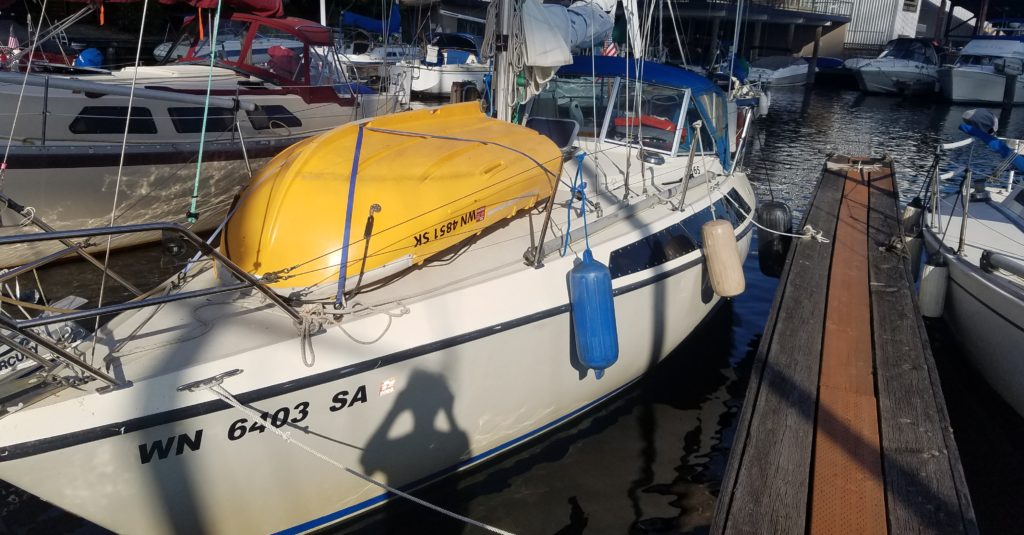
By having good flotation in the bow, I have never gotten even my feet wet while working there. I’m not looking at the waves, just riding the them. But I’ve never been dunked or had water cross the bow– so far.
Eventually, the time came to reef the main at night, and then start making head sail changes. In the beginning, Jennifer would be nearly hysterical having me on deck in the dark. Eventually, it became what we do. Caution and safety are the only way to survive, and we practice both. Sail changes became routine.
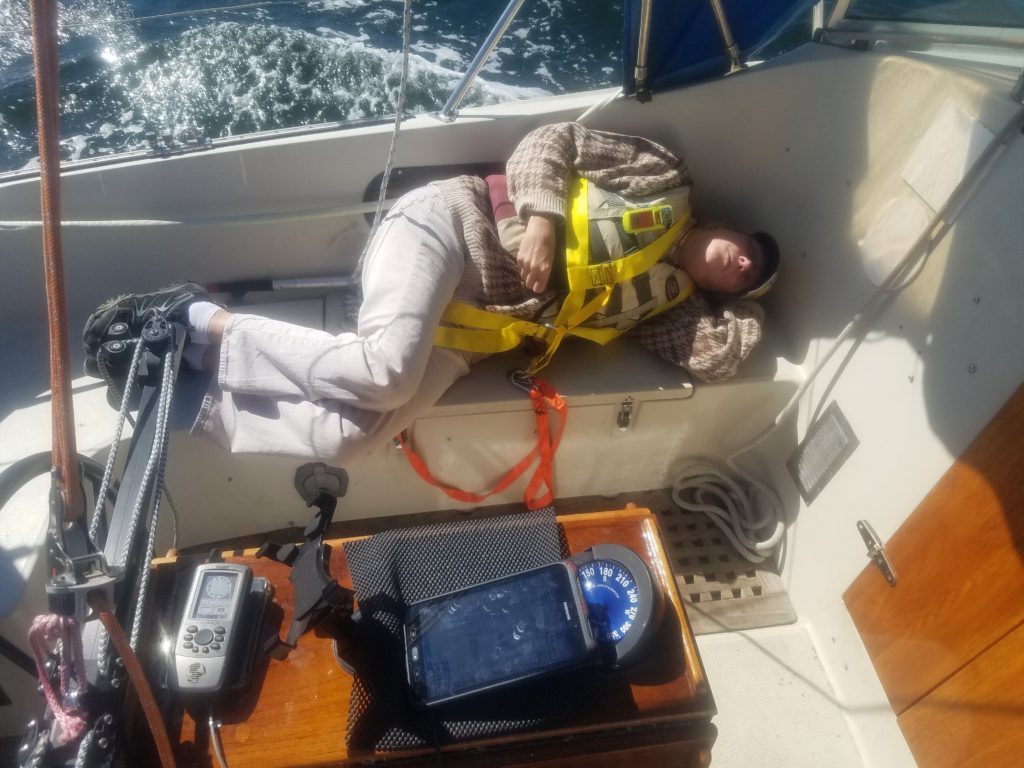
We varied through both legs how many meals we ate, and when we ate them. For a few days we ate only one large meal a day. By this time we were hand steering and were about to realize that only one of us should be awake at a time.
Caro Babbo has no refrigeration. On the Hilo leg of the trip we learned how much of our success with food longevity was related to water temperature. We rarely have a store-bought individual yogurt go bad. On this leg, all thirty went bad.
The cabbage kept, the eggs kept and processed meat in sealed plastics all kept.
Fruits kept in our main cabin netting would go bad faster than in the pnw, but potatoes, sweet potatoes, garlic, ginger and onions all stayed as fresh as ever.
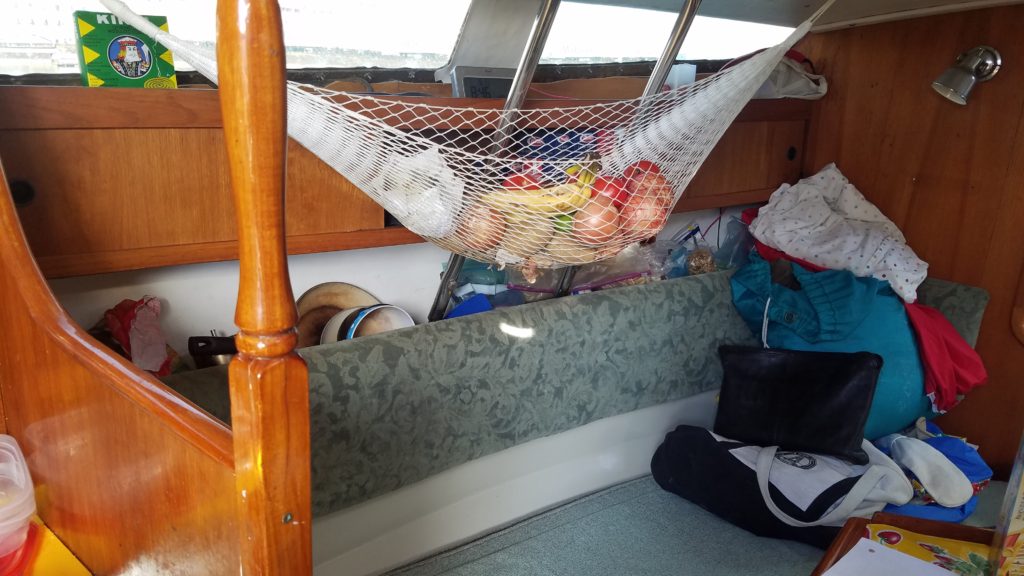
We each lost significant weight on the trip, which was a desire. Now, can we keep it off?
If any change was major, it was our hygiene, which just went to hell. We wore the same clothes for days, we skipped brushing our teeth and I lived in my harness and PFD. I felt that I needed to be ready at any moment to rush on deck and deal with an emergency.
Next time, what broke?

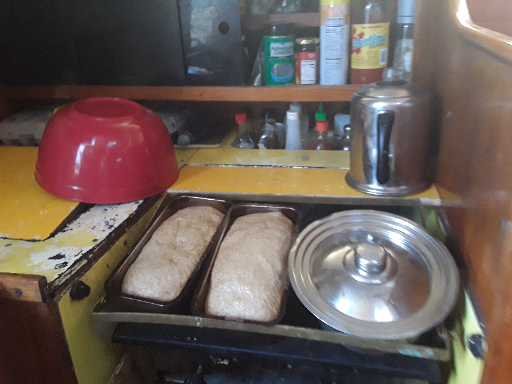
Very nice story. Take care
Regards Vagn